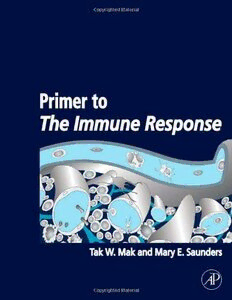
Primer to The Immune Response PDF
455 Pages·2008·25.157 MB·English
Most books are stored in the elastic cloud where traffic is expensive. For this reason, we have a limit on daily download.
Preview Primer to The Immune Response
Description:
Primer to The Immune Response is an invaluable resource for college students, university undergraduates and students in medicine and other health professions who need a concise but complete and understandable introduction to immunology. This book is written in the same engaging conversational style as the published reference book The Immune Response: Basic and Clinical Principles and conveys the same fascinating appeal of immunology. The authors bring clarity, readability and continuity of voice to an audience that requires only a brief survey of the most fundamental concepts in basic and clini. Read more... Front cover; Primer to The Immune Response; Copyright page; Preface to the Text; Preface to the Immunomovie; Biographies; Acknowledgments; Table of contents; PART I: BASIC IMMUNOLOGY; Chapter 1: Introduction to the Immune Response; A. Historical Orientation; B. The Nature of the Immune Response; C. Types of Immune Responses: Innate and Adaptive; D. Interplay between the Innate and Adaptive Responses; E. Clinical Immunology; Chapter 2: Components of the Immune System; A. Cells of the Immune System; B. How Leukocytes Communicate; C. Lymphoid Tissues; D. Cellular Movement in the Immune System. Chapter 3: Innate ImmunityA. Non-Induced Innate Mechanisms; B. Induced Innate Mechanisms; Chapter 4: The B Cell Receptor: Proteins and Genes; A. Immunoglobulin Proteins; B. Immunoglobulin Genes; C. Antigen-Antibody Interaction; Chapter 5: B Cell Development, Activation and Effector Functions; A.B Cell Development: Maturation Phase; B.B Cell Development: Differentiation Phase; C. Effector Functions of Antibodies; D. Immunoglobulin Isotypes in Biological Context; Chapter 6: The Major Histocompatibility Complex; A. Overview of the Major Histocompatibility Complex. B. MHC Class I and Class II ProteinsC. MHC Class I and Class II Genes; D. Physiology of the MHC; Chapter 7: Antigen Processing and Presentation; A. Overview of Antigen Processing and Presentation; B. Exogenous Antigen Processing; C. Endogenous Antigen Processing; D. Cross-Presentation on MHC Class I; E. Other Methods of Antigen Presentation; Chapter 8: The T Cell Receptor: Proteins and Genes; A. TCR Proteins and Associated Molecules; B. TCR Genes; C. TCR-Antigen Interaction; Chapter 9: T Cell Development, Activation and Effector Functions; A.T Cell Development; B.T Cell Activation. C. Th Cell Differentiation and Effector FunctionD. Tc Cell Differentiation and Effector Function; E. Control of Effector T Cells; F. Memory T Cells; Chapter 10: Regulation of Immune Responses in the Periphery; A. Self Tolerance of Lymphocytes in the Periphery; B. Control of Lymphocyte Responses in the Periphery; C. Special Tolerance Situations; D. Experimental Tolerance; Chapter 11: NK, gd T and NKT Cells; A. Natural Killer (NK) Cells; B. gd T Cells; C. NKT Cells; Chapter 12: Mucosal and Cutaneous Immunity; A. Mucosal Immunity; B. Cutaneous Immunity; PART II: CLINICAL IMMUNOLOGY. Chapter 13: Immunity to InfectionA. The Nature of Pathogens and Disease; B. Innate Defense against Pathogens; C. Immunity to Extracellular Bacteria; D. Immunity to Intracellular Bacteria; E. Immunity to Viruses; F. Immunity to Parasites; G. Immunity to Fungi; H. Prions; Chapter 14: Vaccination; A. Vaccine Design; B. Types of Vaccines; C. Adjuvants and Delivery Vehicles; D. Prophylactic Vaccines; E. The "Dark Side" of Vaccines; F. Passive Immunization; G. Future Directions; Chapter 15: HIV and Acquired Immunodeficiency Syndrome; A. What Is HIV?; B. HIV Infection and AIDS
See more
The list of books you might like
Most books are stored in the elastic cloud where traffic is expensive. For this reason, we have a limit on daily download.
